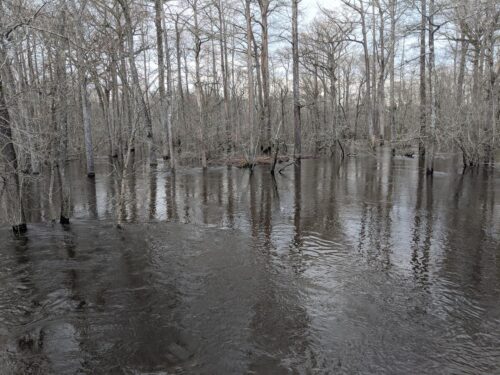Field Notes: Bottomland Forests and Flooding
April 16, 2020 10:41 am

By Scott Bachman, senior area forester
I will confess, when I moved to Isle of Wight County as a much younger forester, I was concerned about the “swamps” and how I would ever work in this environment. Three decades later I have learned to enjoy the bottomland forests and to appreciate the ecosystem services they provide.
One such service is floodwater storage and energy dissipation. In mid-February this year, much of the Commonwealth experienced significant rainfall. DOF personnel in the mountains were tasked with missions to assist with flash flood recovery. In the coastal plain of Virginia, we received similar rainfall but no significant flash floods. As you undoubtedly guessed, that is because we do not have mountains!
Nevertheless, water still must run off the land. An inch of rain on an acre of land equates to a bit more than 27,000 gallons. Where does it all go if it cannot run off rapidly? It spreads out into our floodplains!
Virginia has two types of floodplains: red river bottomlands and blackwater river bottomlands. Red rivers have their headwater in the Piedmont or above. Their waters contain clay sediments and tend to be brown or “red”. The James River is one. Blackwater rivers have their headwaters in the coastal plain. The waters of in these rivers tend to be dark and tannic, nearly like dark tea. The Blackwater River in Isle of Wight is one. There are implications for fish and aquatic systems, but that is a post for the Virginia Department of Game and Inland Fisheries.

There is an incredible amount of energy held in moving water, especially floodwaters. We are reminded, when flooding is eminent, to never try to drive or walk across a flooded road. In flash floods, this energy is expended in uprooting trees, sweeping away cars and homes, and washing out bridges and culverts (thus the need for proper best management practices in timber harvest operations.) In the wide, flat floodplains of the coastal area, this water energy is stored and slowly released by spreading out over the flat lands adjacent to the river bottoms.
The friction from the water striking the buttressed roots of the wetland-adapted trees slows the water, dropping sediment and releasing energy. This water, clearer of sediments, will slowly leave the river bottom and eventually reach an estuary before finally making it to the ocean. These can be slow-moving, long-duration flood events.
Unfortunately, some of our oldest towns and cities are built close to these floodplains, as they were the superhighways of the earlier times. When the floodplains are not able to hold all the rains, these communities can be inundated with flood waters for extended periods.
It is important for us to recognize the ecosystem services that our forests provide. Most of us know about the more obvious services forests provide – clean air, wildlife habitat and carbon sequestration. Floodwater storage and sediment reduction may be other services that you had not considered.
Tags: Ecosystem Services, Roots, Water Quality
Category: Forest Management, Water Quality
